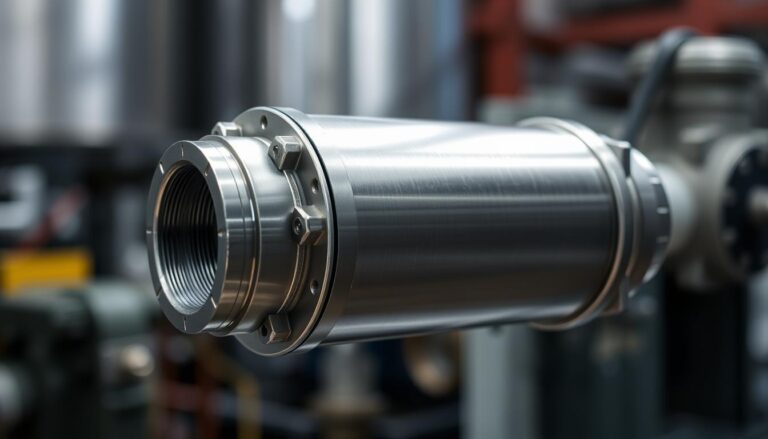A bulkhead fitting is key in many fields, like plumbing and marine. It connects pipes and hoses securely, preventing leaks. In plumbing, it links pipes through walls or tanks. For marine use, it connects hoses and pipes on boats and ships.
A close-up view of a stainless steel bulkhead fitting with intricate details, showcasing its threaded ends and smooth surface, set against a blurred industrial background, reflecting light and enhancing its metallic shine.
Choosing the right bulkhead fitting involves several factors. You need to think about the material, size, and pressure rating. A good fitting is durable, reliable, and can handle different conditions. This article will cover the types of bulkhead fittings, their uses, and what to look for when picking the best one. This applies to plumbing, marine, or industrial needs.
Understanding Bulkhead Fittings and Their Purpose
Bulkhead fittings are key in industrial and residential fields. They ensure pipes and tubes are securely connected, preventing leaks. Their main job is to let fluids, gases, or substances pass through walls while keeping the structure strong.
In industrial use, they handle high-pressure systems. Here, corrosion-resistant materials are vital for durability. At home, they help in plumbing, connecting pipes and fixtures without leaks.
What is a Bulkhead Fitting?
A bulkhead fitting is made to go through walls or bulkheads. It has a threaded or flanged part that seals with a gasket or O-ring.
Common Applications
Bulkhead fittings are used in many ways, including:
- Industrial processes, such as oil and gas production, chemical processing, and power generation
- Residential plumbing systems, including water supply lines and drainage systems
- Marine applications, such as shipbuilding and offshore platforms
Key Components and Features
Bulkhead fittings have a body, a connection part, and a seal. The body is often made from corrosion-resistant materials like stainless steel or PVC. This ensures they last long and work well.
Types of Bulkhead Fitting Materials
Choosing the right material for bulkhead fittings is key. It affects how well they work in marine and plumbing systems. The material must resist corrosion, be strong, and work well with the fluid it carries.
Bulkhead fittings come in various materials like stainless steel, bronze, and PVC. Each has its own benefits and drawbacks. Stainless steel is great for marine use because it’s strong and resists corrosion well. Bronze, however, is a top pick for plumbing due to its durability and resistance to corrosion.
Here are some important traits of bulkhead fitting materials:
- Corrosion resistance
- Strength and durability
- Compatibility with fluids
- Cost and availability
In marine settings, picking the right material is crucial for safety and reliability. For plumbing, the material must handle water and other fluids without corroding. Knowing about different materials helps users choose the best one for their needs.
Essential Factors to Consider When Choosing a Bulkhead Fitting
Choosing the right bulkhead fitting is crucial. It’s important for both residential and industrial uses. The fitting must meet certain standards to work properly and safely.
The pressure rating is a key factor. It must handle the pressure of the fluid or gas. The size and threading also matter. They ensure the fitting fits with other system parts.
Key Considerations
- Size and threading requirements
- Pressure rating considerations
- Environmental compatibility
- Cost vs. quality balance
In industrial settings, the pressure rating is very important. High-pressure systems need fittings that can handle extreme conditions. For residential uses, cost and ease of installation are key. But, the pressure rating is still important.
By looking at these factors and your specific needs, you can pick a fitting that works well. It will provide reliable performance.
| Application | Pressure Rating | Size and Threading |
|---|---|---|
| Residential | Low to medium | Standard sizes |
| Industrial | High | Custom sizes available |
Installation Guidelines for Bulkhead Fittings
Proper installation of bulkhead fittings is key to a secure and leak-free connection. It’s important to follow specific guidelines for bulkhead fittings. The process includes preparing the bulkhead, choosing the right fitting, and tightening the connections.
The installation of bulkhead fittings can be complex. It’s crucial to understand the components involved. Key considerations include:
- Ensuring the bulkhead is properly prepared and cleaned before installation
- Selecting the right type of bulkhead fitting for the specific application
- Tightening the connections securely to prevent leaks
By following these guidelines and understanding bulkhead fitting requirements, a successful installation can be achieved. Bulkhead fittings are designed for a secure and reliable connection. Proper installation is vital for their performance and longevity.
It’s also important to consider the specific installation needs for the bulkhead fitting type. This includes material, size, and threading requirements. By understanding these needs and following the recommended guidelines, a successful installation can be ensured. This provides a reliable connection.
Common Applications Across Different Industries
Bulkhead fittings are used in many fields like marine, industrial, and residential. They help connect pipes and tubes securely, preventing leaks. In boats and ships, they manage fuel, water, and other fluids.
In factories and plants, they handle chemicals and gases. At home, they connect water and gas pipes. These fittings make connections safe and reliable, lowering the chance of accidents.
Marine Applications
In the marine world, bulkhead fittings keep pipes and tubes tight. They’re built to last in the sea’s harsh conditions. They’re used for:
- Connecting fuel pipes and tubes
- Connecting water pipes and tubes
- Connecting pipes and tubes that carry other fluids
Industrial Uses
In industrial settings, bulkhead fittings are key for safety. They connect pipes and tubes with chemicals, gases, and more. They help avoid leaks and accidents. They’re used for:
- Connecting pipes and tubes that carry chemicals
- Connecting pipes and tubes that carry gases
- Connecting pipes and tubes that carry other fluids
Residential Plumbing Solutions
In homes, bulkhead fittings are crucial for plumbing. They connect water and gas pipes safely. They’re used for:
- Connecting water pipes and tubes
- Connecting gas pipes and tubes
- Connecting pipes and tubes that carry other fluids
Bulkhead fittings are vital in many industries. They ensure safe connections in marine, industrial, and residential areas. This reduces the risk of leaks and accidents, making operations safer and more efficient.
Maintenance and Care Tips for Long-lasting Performance
Proper maintenance and care are key for it to last long. Regular checks and cleanings stop corrosion and damage. They also lower the chance of leaks and other problems.
Here are some tips for keeping it in good shape:
- Regularly inspect the fittings for signs of wear and tear
- Cleaning the fittings with a soft brush and mild soap solution
- Applying a rust-inhibiting coating to protect against corrosion
- Replacing worn-out parts and gaskets as needed
By following these tips and being proactive, you can make your bulkhead fittings last longer. This ensures they keep working well and efficiently.
Troubleshooting Common Bulkhead Fitting Issues
Dealing with it means you need to troubleshoot often. This ensures your system works well for a long time. Finding and fixing the main problem helps avoid future issues. Leak prevention is especially important to avoid damage and keep your system running.
Leaks, connection problems, and corrosion are common issues. Knowing how your fitting works is key. Use tools to find leaks and check for damage. Regular cleaning and checks can also stop problems before they start.
Leak Prevention and Detection
Stopping leaks is vital for it care. Preventing leaks saves your equipment and avoids expensive fixes. Use top-notch fittings, install them right, and check them often for damage.
Solving Connection Problems
Connection issues are common with it. They often happen if the fitting is not installed correctly or if threads are damaged. Check the fitting and connected parts to find the problem. Sometimes, just tightening or replacing a thread fixes it.
Follow these tips to keep it working well. Troubleshooting and preventing problems saves time and money. Regular checks and maintenance keep your fittings running smoothly and efficiently.
Conclusion: Making the Right Choice for Your Bulkhead Fitting Needs
Choosing the right it is key for your project’s success and safety. This is true in marine, industrial, or residential areas. Think about size, pressure rating, material, and cost to make a smart choice.
High-quality, well-installed it save time, money, and stress. Follow the installation tips and keep your fittings in good shape. This way, they’ll last longer and work better for years.
Now, you know how to pick the best it for your needs. You can confidently choose the right one. Enjoy the satisfaction of a job well done.
FAQ
What is a bulkhead fitting?
it is a plumbing and industrial connector. It creates a leak-proof seal between two surfaces, like walls or partitions. These fittings are key in marine, residential, and commercial settings.
What are the common applications of bulkhead fittings?
it used in many ways. They secure pipes, cables, and hoses in boats and ships. They also pass pipes through walls and floors in buildings. Plus, they create secure connections in industrial equipment and tanks.
What are the key components and features of a bulkhead fitting?
it has several important parts. It has a threaded body, a gasket or seal, and a locknut or flange. It’s made from materials like stainless steel, bronze, and corrosion-resistant plastics.
What factors should I consider when choosing a bulkhead fitting?
When picking a bulkhead fitting, think about a few things. Check if the size and threading fit your needs. Also, consider the pressure rating and environmental compatibility. Balance the cost with the quality and performance.
How do I properly install a bulkhead fitting?
Installing it right is key for a leak-free connection. First, prepare the surface with a clean, smooth hole. Then, apply sealant or thread tape to the threads. Insert the fitting and secure it with the locknut or flange. Finally, tighten it well but avoid overdoing it.
What are some common applications of bulkhead fitting across different industries?
it used in many industries. They secure hoses, pipes, and cables in boats and ships. They also connect pipes and tubing in manufacturing and tanks. And, they pass plumbing pipes through walls and floors in homes and buildings.
How do I maintain and care for my bulkhead fittings?
Keeping it in good shape is important. Regularly check for wear, damage, or leaks. Clean them with mild detergent and water. Replace worn or damaged parts to prevent leaks. Store spare parts for easy access.
How can I troubleshoot common bulkhead fitting issues?
If you have problems with it, here’s what to do. Check for leaks and fix any cracks or loose connections. Make sure the fittings fit and were installed correctly. If they’re worn or damaged, it’s time for new ones.


